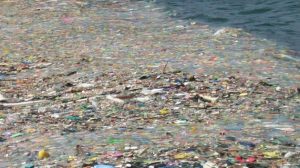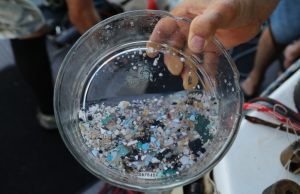What is the Pacific Gyre and Why Should You Care?
What is the Pacific Gyre?
The Pacific Gyre consists of a broad expanse of the North Pacific Ocean. This area is where 3 major ocean currents converse, creating a oceanic desert due to the rotational movements of the seas. Because there are very few fish in the area, it is usually avoided by fishermen and sailors. Within the last twenty years, something even more startling than the biggest fish in the ocean has been discovered within the Pacific Gyre: the world’s largest landfill.

Image via Envirocon
The world’s largest landfill is actually floating in the Pacific Ocean, filled with millions of pounds of trash and plastics. The mass of garbage is actually separated into two main patches. The Eastern Pacific Garbage patch floats between Hawaii and California, and the Western Pacific Garbage Patch will floats between Japan and Hawaii. Scientists estimate at the Eastern Pacific Garbage Patch, the one located just miles from US shores, is nearly two times as large as the state of Texas.
This garbage patch presents a serious risk to marine life, the fishing industry, and tourism. Because plastic doesn’t biodegrade, as it floats in the oceans, it breaks down into smaller and smaller fragments. This process, called photodegrading, leaves these small fragments of plastics floating throughout the upper hundred feet of water. The plastic fragments are often referred to as mermaid tears.
Image via Algalita
How is Marine Life Affected by the Trash in the Pacific Gyre?
Marine life is directly affected by the trash in the Pacific Gyre because many species will ingest the fragments of plastic, confusing it for food. The Albatross, a large bird commonly found throughout the Pacific Ocean, loses almost 50% of their young that are born on islands surrounding the Pacific Gyre. Research has found that the majority of the young bird’s deaths are the result of being fed plastic fragments.
At this point, most would simply say “Use a bunch of nets and clean it up!” Unfortunately, that option would not be effective to begin to remove the trash from these floating garbage patches. Due to plastics photodegrading properties, the majority of the plastic in the Pacific Gyre is in tiny fragments. Attempting to run nets to clean this up would cause damage to other marine life, since the nets would need to be so incredibly fine to pick up the particles that it would scoop up any other organisms in the water at the same time.
Create a Recycling Plan to Benefit Marine Life and the Environment
It’s estimated that over a million birds and marine animals die each year from consuming or being caught in plastic or trash debris. While the Pacific Gyre and the world’s largest dump may be thousands of miles from New Jersey, our actions can have a direct effect on the amount of plastic waste that ends up polluting the Earth. Take time to look at how much plastic that your family consumes in the average week, and come up with a plan on how to reduce that amount through the use of reusable containers, responsible shopping, and a thorough recycling plan for the home.


